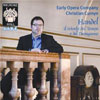Handel (Il) Trionfo e del Disganno
Plenty of verve and detail in this intimate account of Handel’s first Roman oratorio
View record and artist detailsRecord and Artist Details
Genre:
Opera
Label: Wigmore Hall Live
Magazine Review Date: 5/2011
Media Format: CD or Download
Media Runtime: 0
Mastering:
Stereo
DDD
Catalogue Number: WHLIVE0042/2

Author: David Vickers
Curnyn’s shapely handling of ritornellos often leans towards delicacy rather than vigour, and throughout the concert the string playing is immaculate: even the macabre ombra aspects of the fast string figures during the introduction to Tempo’s “Urne voi” are blended sweetly (Andrew Staples’s soft timbre does not convey the chilling horrors implied in Cardinal Pamphili’s libretto at this point but it is ideal for the gently persuasive “Nasce l’uomo ma nasce bambino”). Elsewhere, instrumental parts in rapid arias played quietly and delicately lack nothing in energy (eg Bellezza’s “Un pensiero nemico di pace”), and Curnyn’s interpretations tend to be subtler and less formulaic than those who might pursue the objectives of abrasive dramatic punchiness. Robust cut-and-thrust is lacking but only infrequently; perhaps moments such as Piacere’s exposal in the villainous “Come nembo che fugge col vento” possessed greater vigour in the flesh than the microphones have captured.
The singers deliver an engaging and fervent account of the moral conflict between the evil Piacere (Pleasure) and the virtuous guardians Tempo (Time) and Disinganno (Disenchantment) over the soul of Bellezza (Beauty), who wants to be a disciple of Pleasure but thankfully ends up on the side of the angels just in the nick of time to be saved. Mezzo Anna Stephany reins her voice in with admirable discipline and there is a nice atmosphere of chamber music-making between her vocal lines and solos by organist Mark Williams during Piacere’s “Un leggiadro giovinetto”. Hilary Summers sounds uncomfortable in Disinganno’s “Più non cura” but sings “Crede l’uom” compassionately; the aria’s recorder-laden pastoral shades are judged to perfection by Curnyn (whose own harpsichord continuo realisation is discreet and delightful). Lucy Crowe’s animated coloratura is executed with precision and refinement, her embellishments strike the ideal balance between unpredictability and fitting the harmony naturally, and Bellezza’s slower sentimental music is captivating.
Discover the world's largest classical music catalogue with Presto Music.

Gramophone Digital Club
- Digital Edition
- Digital Archive
- Reviews Database
- Full website access
From £8.75 / month
Subscribe
Gramophone Full Club
- Print Edition
- Digital Edition
- Digital Archive
- Reviews Database
- Full website access
From £11.00 / month
Subscribe
If you are a library, university or other organisation that would be interested in an institutional subscription to Gramophone please click here for further information.




